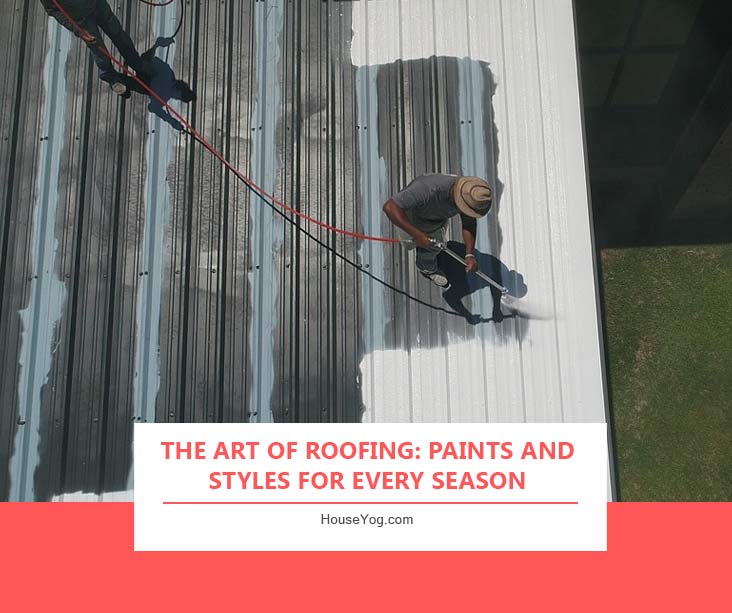A well-maintained roof is not just a practical necessity; it’s an integral part of your home’s overall aesthetic appeal and energy efficiency. Whether you’re looking to refresh an old roof or enhance the longevity of your new one, painting and choosing the right style can elevate the look and performance of your roof across all seasons.
In this article, we’ll delve into The Art of Roofing: Paints and Styles for Every Season, offering practical insights, expert tips, and considerations for selecting roof paints and styles that are not only visually stunning but also protective and energy-efficient.
Why Roof Painting Matters
Before we get into the specifics of paints and styles, it’s important to understand why roof painting is a critical part of roof maintenance. Roofs are constantly exposed to the elements — harsh sun, rain, wind, snow, and even wildlife. Over time, the roof can deteriorate, leading to cracks, rust, leaks, or mold buildup. A fresh coat of paint does more than just add a splash of color; it provides a protective layer that shields your roof from wear and tear.
Roof painting is not just about aesthetics, though it can drastically improve curb appeal. Talking about aesthetics, adding custom paint by numbers can make even a simple wall into a beautiful canvas. A good roof painting job can also enhance your roof’s energy efficiency, water resistance, and longevity.
The Basics of Roof Painting: What You Need to Know
Before diving into the different roof styles and paints for every season, let’s go over some general tips for a successful roof painting project.
Roof Materials and Their Compatibility with Paints
The first thing to consider is the material of your roof. Different roofing materials have different paint compatibility, and some may require specific preparation methods.
Here’s a quick overview:
- Asphalt Shingles: These are the most common roofing materials. Asphalt shingles absorb paint well, but they may require a primer before painting to ensure proper adhesion.
- Metal Roofs: Metal roofs require specific paint formulations, such as acrylic or elastomeric coatings, to prevent rust and corrosion.
- Tile Roofs: Tile roofs are porous, so you’ll need a paint that can penetrate the surface for a strong bond. You may also need a sealing coat for added protection.
- Slate Roofs: Slate roofs are often painted with special masonry coatings to maintain their natural texture and durability.
- Wooden Roofs: Wooden roofs require a paint that offers protection from moisture and UV rays, such as oil-based paints.
Choosing the Right Paint Color and Finish
Color plays a huge role in both the aesthetics and functionality of your roof. For instance, light-colored roofs reflect heat and are perfect for hot climates, while darker roofs absorb heat, making them ideal for cooler regions. When selecting the color, keep the following in mind:
- Light Colors: Reflective and energy-efficient. Ideal for warmer climates.
- Dark Colors: Absorb heat, making them perfect for colder climates.
- Metallic Finishes: Help to reflect UV rays, increasing energy efficiency.
- Earthy Tones: Blend naturally with the environment and work well in suburban and rural areas.
The Best Roof Paints for Every Season
Now that we have the basics covered, let’s explore the paints and styles best suited for different seasons and climates.
Spring: Freshen Up with Lighter Hues
Spring is all about renewal and growth, and it’s the perfect time to freshen up your roof. If your roof has suffered from winter’s harsh elements, spring is the time to repair and protect it. You want a roof paint that can handle a variety of weather conditions, from light showers to sunshine.
Recommended Paint Types for Spring:
- Acrylic Roof Coatings: Acrylic coatings are excellent for the spring, offering flexibility, weather resistance, and UV protection.
- Elastomeric Roof Coatings: Ideal for areas with fluctuating temperatures, elastomeric coatings are perfect for spring when temperatures begin to warm up but still fluctuate.
- Light-colored paints: Reflect more sunlight, keeping your home cooler as the temperature begins to rise.
Summer: Stay Cool with Reflective Roof Paints
Summer brings hot temperatures, so having a roof that can withstand the heat is essential. A reflective roof coating can help lower your energy bills by keeping your home cooler, reducing the need for air conditioning.
Recommended Paint Types for Summer:
- White or Light-colored Roof Coatings: As mentioned, lighter shades reflect heat and sunlight, preventing your home from absorbing too much heat.
- Polyurethane Roof Coatings: Polyurethane offers high resistance to the summer sun and is highly durable, even under intense UV exposure.
- Metallic Roof Paints: Ideal for reflecting sunlight and maintaining roof temperature, reducing the effects of heat absorption.
Fall: Prepare for Cooler Weather with Protective Coatings
As temperatures cool down in the fall, it’s crucial to prepare your roof for the upcoming winter months. Fall roof painting should focus on providing a protective barrier that can withstand wet weather and prevent damage from snow and ice.
Recommended Paint Types for Fall:
- Silicone Roof Coatings: Silicone coatings are great for the fall because they provide a seamless and water-resistant layer that protects the roof from rain and moisture.
- Elastomeric Roof Coatings: As temperatures begin to dip, elastomeric coatings remain flexible and crack-resistant, making them perfect for fall.
- Dark or Neutral-colored Roofs: Darker colors are suitable for fall because they absorb heat, helping to warm your home during the cooler months.
Winter: Shield Against Snow and Ice with Durable Roof Coatings
Winter can be tough on roofs. From heavy snow to freezing rain, your roof needs extra protection. During the colder months, you’ll want to use paints and coatings that can protect your roof from ice dams and water penetration.
Recommended Paint Types for Winter:
- Elastomeric Roof Coatings: Elastomeric coatings are a go-to for winter, as they provide a thick, flexible layer that expands and contracts with the temperature, preventing cracking and leaks.
- Polyurethane Coatings: These coatings are highly durable and resistant to water, making them ideal for snowy or icy climates.
- Reflective Roof Coatings: Some reflective coatings can also help to melt snow faster, reducing the chances of ice dams.
Roof Maintenance Tips: Keep Your Roof Looking and Working Its Best
While painting your roof is essential, regular maintenance ensures that your roof continues to perform well throughout the seasons. Here are a few tips to extend the life of your roof:
- Regular Inspections: Always check for leaks, cracks, or missing shingles. Look for signs of wear and tear, such as water damage or moss/algae growth.
- Clean Your Roof: Keeping your roof free from debris, leaves, and moss can help prevent damage and preserve the paint.
- Seal Cracks: Use a quality sealant to repair any visible cracks in the roofing material, especially before winter.
- Trim Overhanging Branches: Avoid unnecessary damage to your roof by trimming any branches that hang over it, especially during stormy seasons.
DIY vs. Professional Roof Painting: What’s Best for You?
One question homeowners often ask is whether to paint their roof themselves or hire a professional. Let’s break it down:
DIY Roof Painting
- Pros:
- Lower cost compared to hiring a professional.
- Control over color choices and paint brands.
- Satisfaction of completing the project yourself.
- Cons:
- Time-consuming and physically demanding.
- Risk of poor results if not done correctly (e.g., uneven coverage, missed spots).
- Lack of expertise in applying coatings for specific roof materials.
Professional Roof Painting
- Pros:
- Expertise in selecting the right paint and coating for your roof type.
- Fast and efficient application.
- Long-term warranty on the work done.
- Cons:
- Higher upfront cost.
- Limited control over paint choices unless specified.
Final Thoughts: The Art of Roofing for Every Season
The Art of Roofing: Paints and Styles for Every Season isn’t just about making your roof look good — it’s about making sure it lasts and performs well through changing weather conditions. Whether you choose a DIY route or hire a professional, the right paint and coatings can add years to your roof’s life, increase energy efficiency, and improve your home’s curb appeal.If you’re looking for roof painting services or roof restoration, be sure to choose a qualified contractor who understands the complexities of different roofing materials and climates. And no matter the season, taking the time to maintain your roof and apply the right paints and coatings will pay off in the long run.






